Variation: Sourdough English Muffins
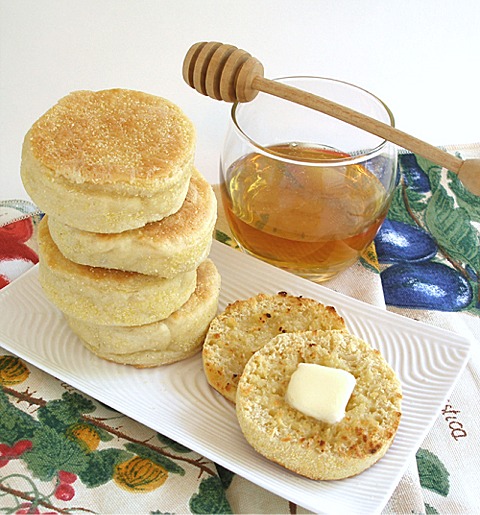
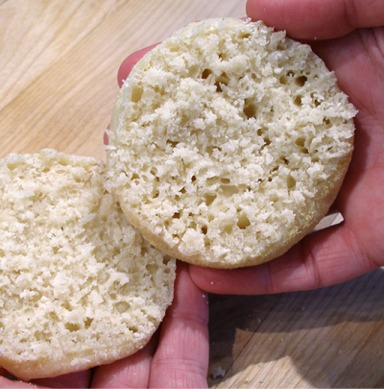
These are nice and crunchy(when toasted) on the outside, and chewy in the center, with lots of nooks and crannies for the butter. :^) My recipe is mixed using at chemical leavener at the end to ensure a bubbly interior producing the wonderful nooks and crannies always associated with them; it's a technique I adapted from both Michael Ruhlman and Peter Reinhart. The dough is more like a thick sticky batter; it can be spooned onto a cornmeal dusted griddle, either free form, which this is the perfect recipe for. You can optionally, place the batter into English Muffin (Crumpet) rings, forming the perfect shape. (You can fashion 3-inch rings out of foil.) Don't let the lack of crumpet rings stop you from making these; you can also use the rims of quart-size canning jars. The cornmeal keeps them from sticking to the hot griddle and also adds the textured bottom. Toasting the finished English muffins began apparently because leftover ones became dry and tough and it was done to make them more palatable.
BREAD RECIPE HELP
INGREDIENTS
1/2 cup water; 100 to 110 degrees F; measured with an instant read thermometer
1 package active dry yeast (2-1/4 teaspoons, .25 ounces or 7 grams)
2 teaspoons honey, mild flavored
1 1/2 cups whole or 2% milk; 100 to 110 degrees F; measured with an instant read thermometer
4 tablespoons unsalted butter, melted and cooled
4 cups unbleached all-purpose or bread flour; spoon into measuring cup and level to rim; more or less as needed
1 1/2 teaspoons salt
1 large egg, lightly beaten
2 teaspoons baking powder
1 tablespoon warm water , about 101 degrees F (a little warmer than body temperature)
Yellow cornmeal or Semolina for dusting; will give your muffins a typical crunchy English muffin crust. (Why not cornmeal, instead of semolina? Cornmeal burns easily.)
INSTRUCTIONS
Make the thick and sticky batter:
1. In a medium size bowl, combine the flour and the salt. Set aside.
KELLY SAYS: I like to sift my flour and salt together after measuring.
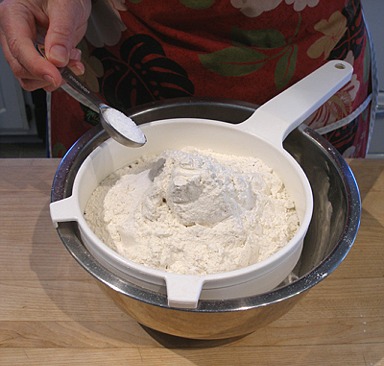
2. Rinse the mixing bowl to a stand mixer with hot water to warm it. Clamp it on the stand mixer. Fit the mixer with a paddle attachment.
3. Place the measured water in the mixer bowl. Sprinkle the yeast over its surface and let stand for a few minutes. Whisk the yeast until it has fully absorbed the water.
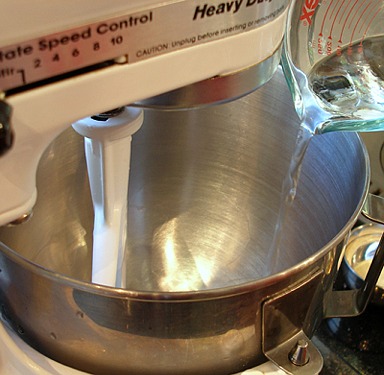
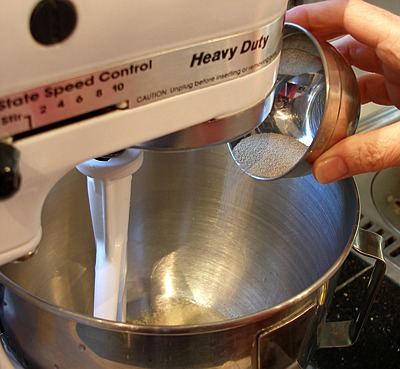
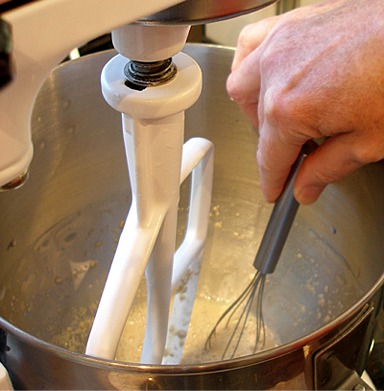
4. Add the honey to the yeast and stir. It will start to bubble a little.
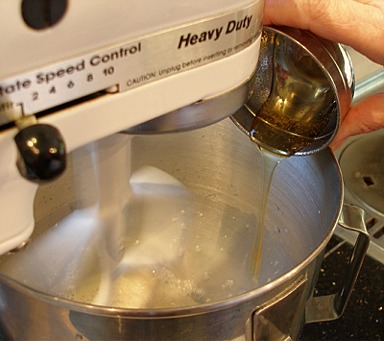
5. Combine the milk and melted butter and immediately add it to yeast mixture.
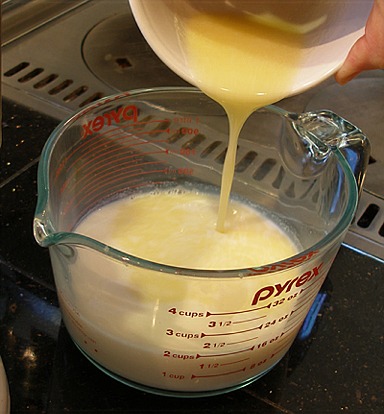
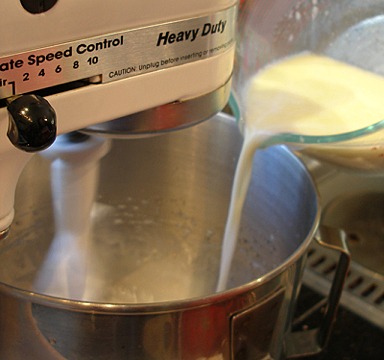
6. Turn on the mixer to low, and add in 1/2 cup all-purpose flour mixed with the salt.
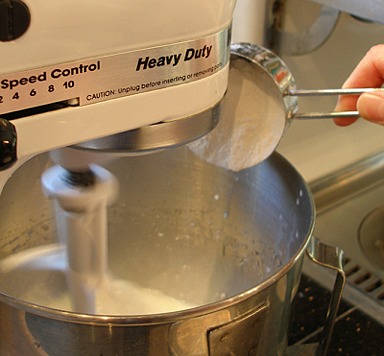
7. Add in the egg.
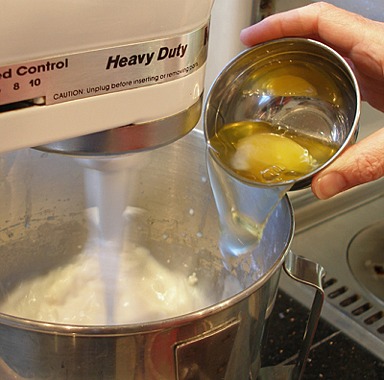
8. Add in the remaining flour and salt mixture, 1/2 cup at a time, with the mixer on low until combined.
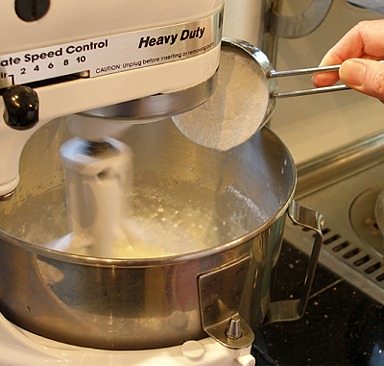
Add flour and salt mixture until the mixture is a thick sticky batter. The batter will need to be spooned; it will not pour. You may not need all of the flour mixture.
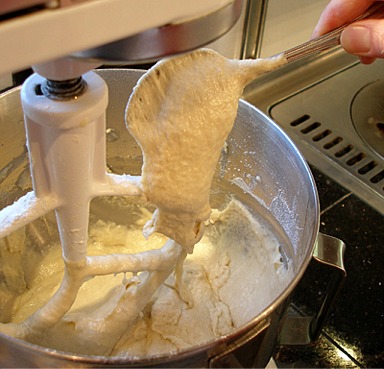
9. Scrape the batter into a large bowl. Cover with greased-side down plastic wrap and set aside in a warm room for 1 1/2 hours, or refrigerate overnight.
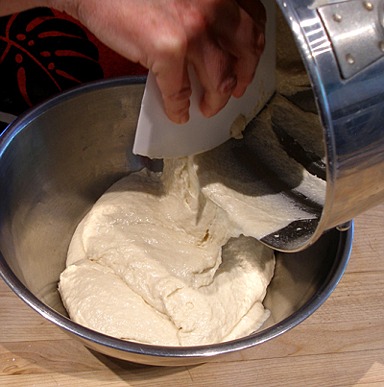
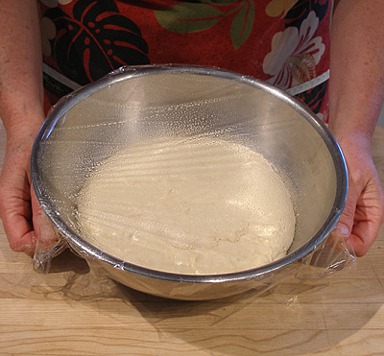
Cook the English muffins:
NOTE: If refrigerated, about 1 to 2 hours before cooking, remove the batter from the refrigerator. Do NOT remove the plastic wrap. The dough will have risen and will be sticky.
The batter will produce more bubbles as it comes to room temperature.
This batter was left to rise in a warm room for 1 1/2 hours!
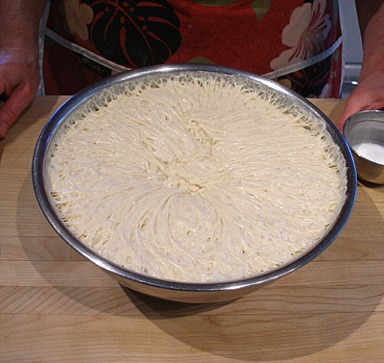
1. When ready to cook, heat a large griddle or a skillet over medium heat. (300 degrees F if using an electric skillet. )
Do not grease or oil the griddle.
SARAH SAYS: A cast iron skillet is perfect!
2. Mist the insides of the crumpet rings with spray oil, then dust the insides of the rings with cornmeal.
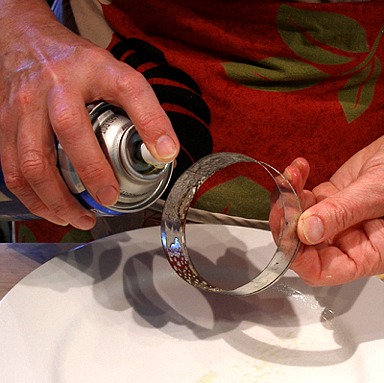
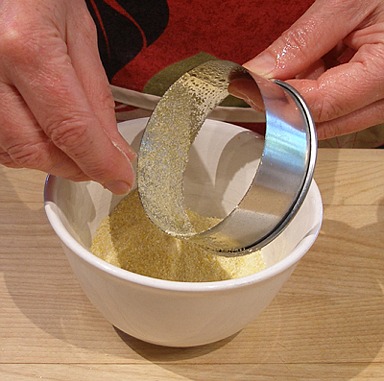
3. Also, preheat the oven to 350 degrees F with the oven rack on the middle shelf. Line a baking sheet with parchment paper or a nonstick Silpat mat.
4. Carefully remove the plastic wrap from the English muffin batter.
5. Stir the baking powder into the warm water.
Make sure the baking powder has dissolved and starts to produce foam; it will if the water is warm and the baking powder has not lost its potency.
Do NOT let the mixture sit because you will lose valuable carbon dioxide bubbles needed in the English muffin batter.
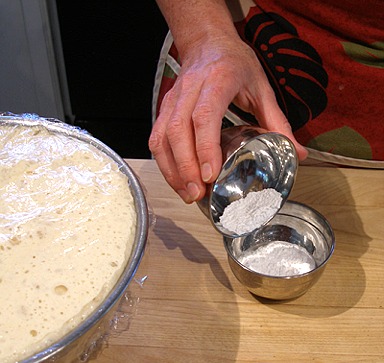
Immediately, pour the dissolved baking powder into the middle of the risen batter.
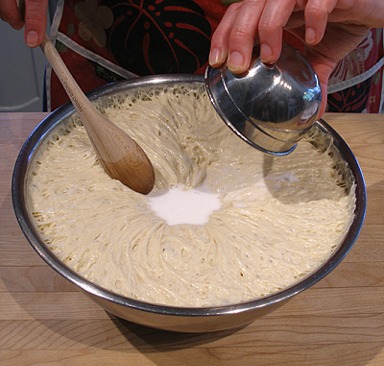
With a large wooden spoon, quickly stir it in, using wide circular motions, until dissolved baking soda is fully absorbed.
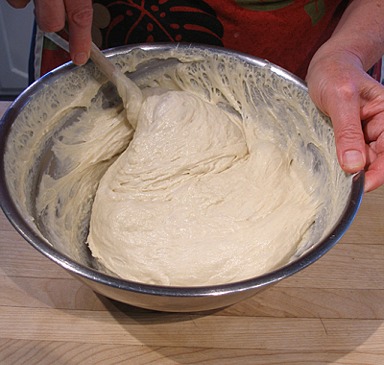
Let the batter rest for 5-10 minutes or until the English muffin batter starts bubbling again.
6. Meanwhile, dust the griddle or skillet with cornmeal if NOT using rings.
If using rings, cover the surface of the pan with as many prepared rings as it will hold, then dust the pan inside the rings with cornmeal.
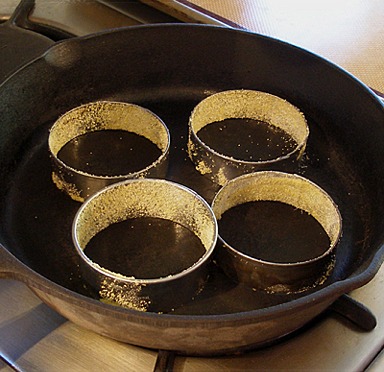
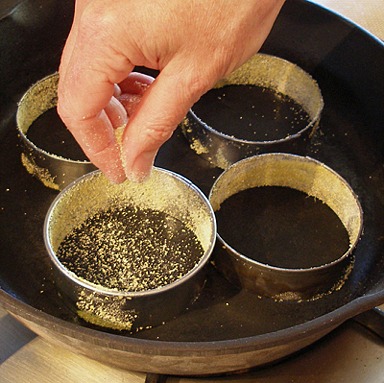
7. Mist a 1/4-cup measuring cup with spray oil. Almost fill it with batter and scoop it onto the griddle, free form into a mound or into the prepared rings, filling them almost to their rims.
Make sure you get all of the batter from the measuring cup with a small rubber spatula. If free form, space the batter at least 1-inch apart; it will spread slightly.
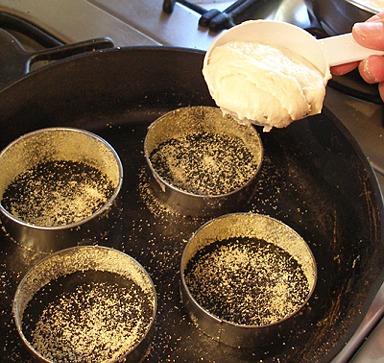
Then, sprinkle a small amount of cornmeal over each muffin.
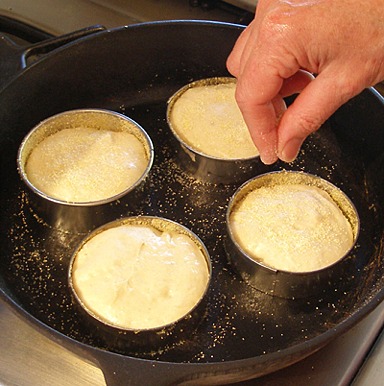
8. Cook for about 7 – 8 minutes. The English muffins will slowly rise just a little and bubble. Adjust the heat if the bottoms are starting to burn.
Cook until the bottoms are a rich golden brown and the tops lose their wet look.
When done, flip them over, (rings and all, if using).
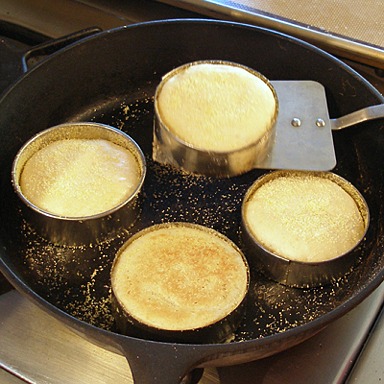
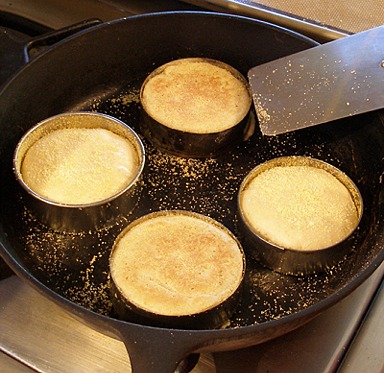
9. Continue cooking until done, another 7 to 8 more minutes.
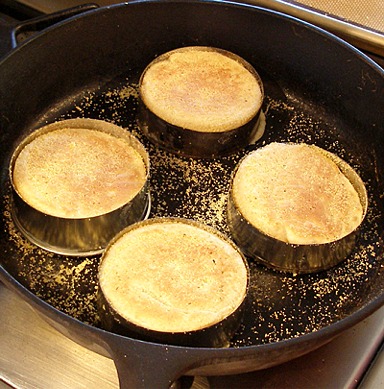
SARAH SAYS: Be sure to cook them all the way through. If it takes less than 7 minutes per side, your griddle setting is probably too high and you'll end up with undercooked muffins.
10. When both sides are golden brown and the dough is springy to the touch, remove the muffins from the griddle to the prepared baking sheet.
Bake the English muffins in a preheated oven for 5 minutes to make sure they’re done.
NOTE: If using rings, first remove the muffins from the griddle to the prepared baking sheet. Carefully remove the rings. Then, place the ringless muffins back onto the prepared baking sheet, and bake.
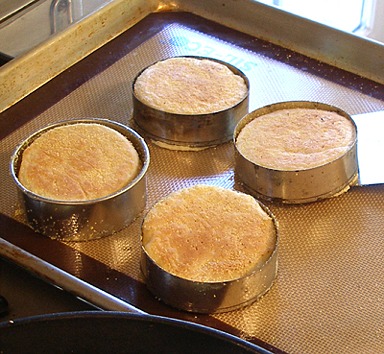
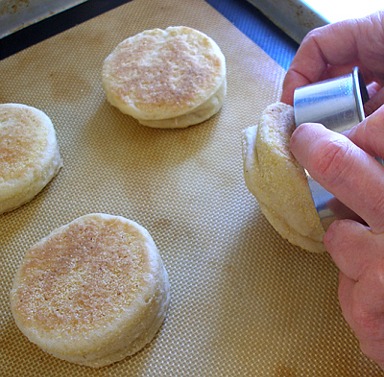
11. When done, place the muffins on a wire cake rack, on their edges to cool; this will help prevent sinking and shrinking. Cool for at least 15 – 30 minutes before serving.
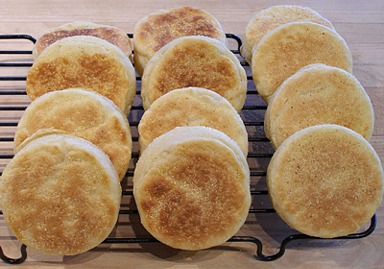
SERVE
Pry in half with a fork, rather than a knife to accentuate the interior nooks. Toast and serve with butter, honey, or jam.
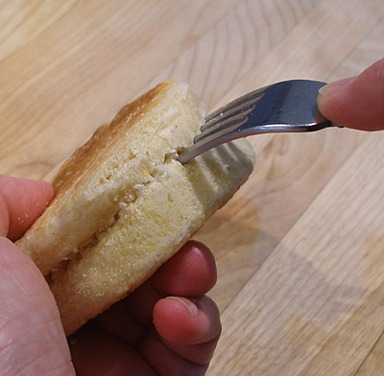

STORAGE
Keep muffins tightly wrapped and store at room temperature for a few days; refrigerator storage is not recommended because they quickly dry out and become stale.
They freeze well for a month or more, tightly wrapped. (You can split them ahead of time). Thaw in their wrappers at room temperature.
VARIATIONS
Sourdough English Muffins



